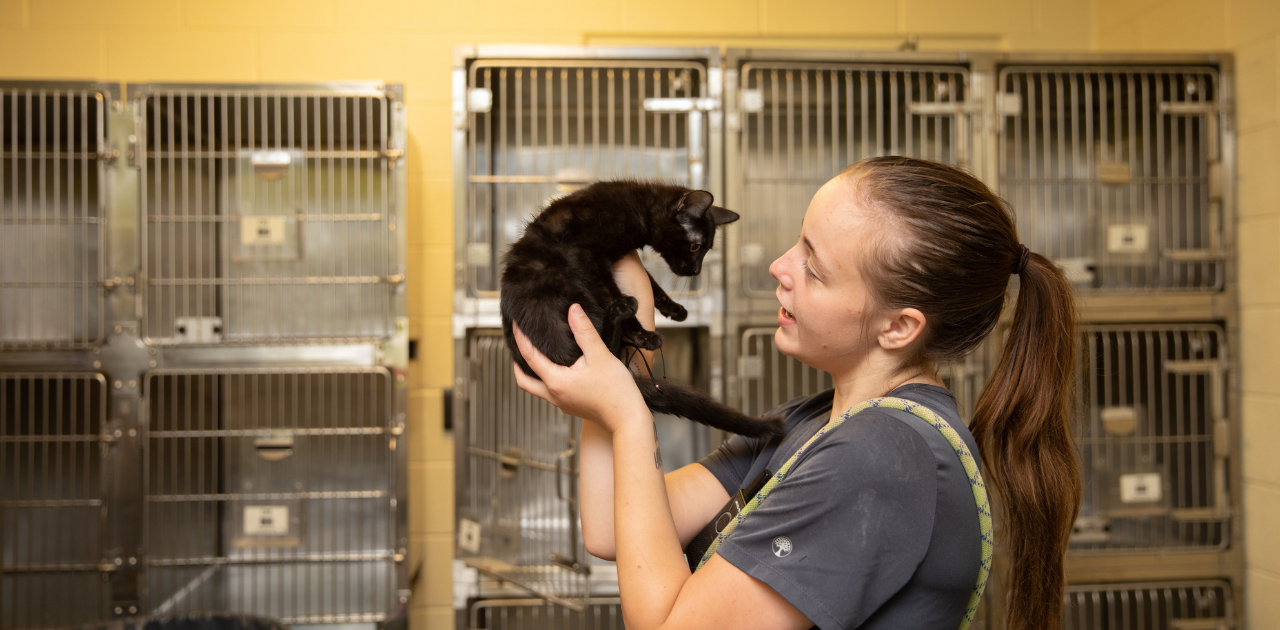
Shelter pet lifesaving is improving for the first time since the pandemic
January–September 2024 Data Report
We’re three quarters of the way through 2024 and though we faced a very busy summer, it’s time to pause and cautiously celebrate as monthly data trends paint an encouraging picture for the rest of the year and into 2025.
Let’s start with the best news. Based on sample data from January – September**, shelters across the country are poised to see the first decrease in animals killed since the pandemic began – a 3.4% decrease in the number of animals killed in our sample compared to the same period in 2023. This represents the first positive national trend in lifesaving since 2020 and the start of the Covid 19 pandemic.
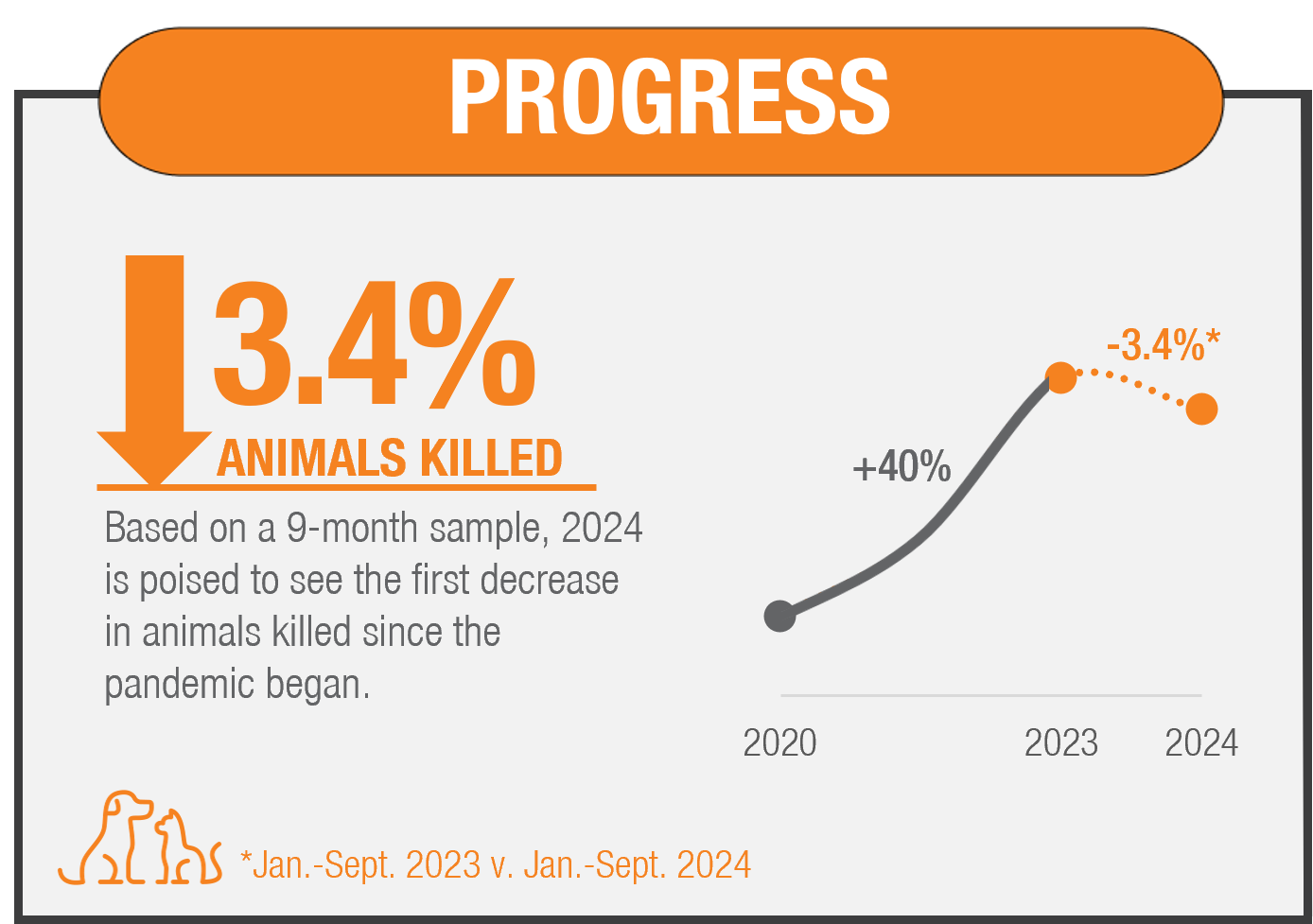
It’s no secret that it’s been tough for shelters since the pandemic dramatically altered the animal welfare landscape, resulting in lagging adoptions and staffing shortages. It’s been a long, hard road, but all your hard work and dedication have built momentum and it’s a great sign the trendline is once again moving in a positive direction. Because of your persistence, thousands more animals found loving homes this year than in the last.
Cats are making up the biggest improvement, seeing a 5.1% decrease in the number of cats killed thus far in 2024.
Another positive indicator of lifesaving in 2024 is a 4% increase in adoptions for cats and dogs in our sample of shelters.
Rising dog intake
Unfortunately, dog intake remains slightly higher thus far in 2024 than in 2023, with municipal shelters seeing most of the increase. That means that while adoptions are increasing, municipal shelters continue to struggle with elevated intake. To get ahead of their capacity challenges, municipal organizations will need to continue to increase outcome avenues (such as adoptions, transfers and foster homes) and prevent animals from unnecessarily entering their building through programs such as direct rehoming and return-to-home in-field.
Strategic managed intake resources
Dog adoptions by organization type
Breaking dog adoptions down by organization type reveals dog adoptions are up in some organization types, but not others.
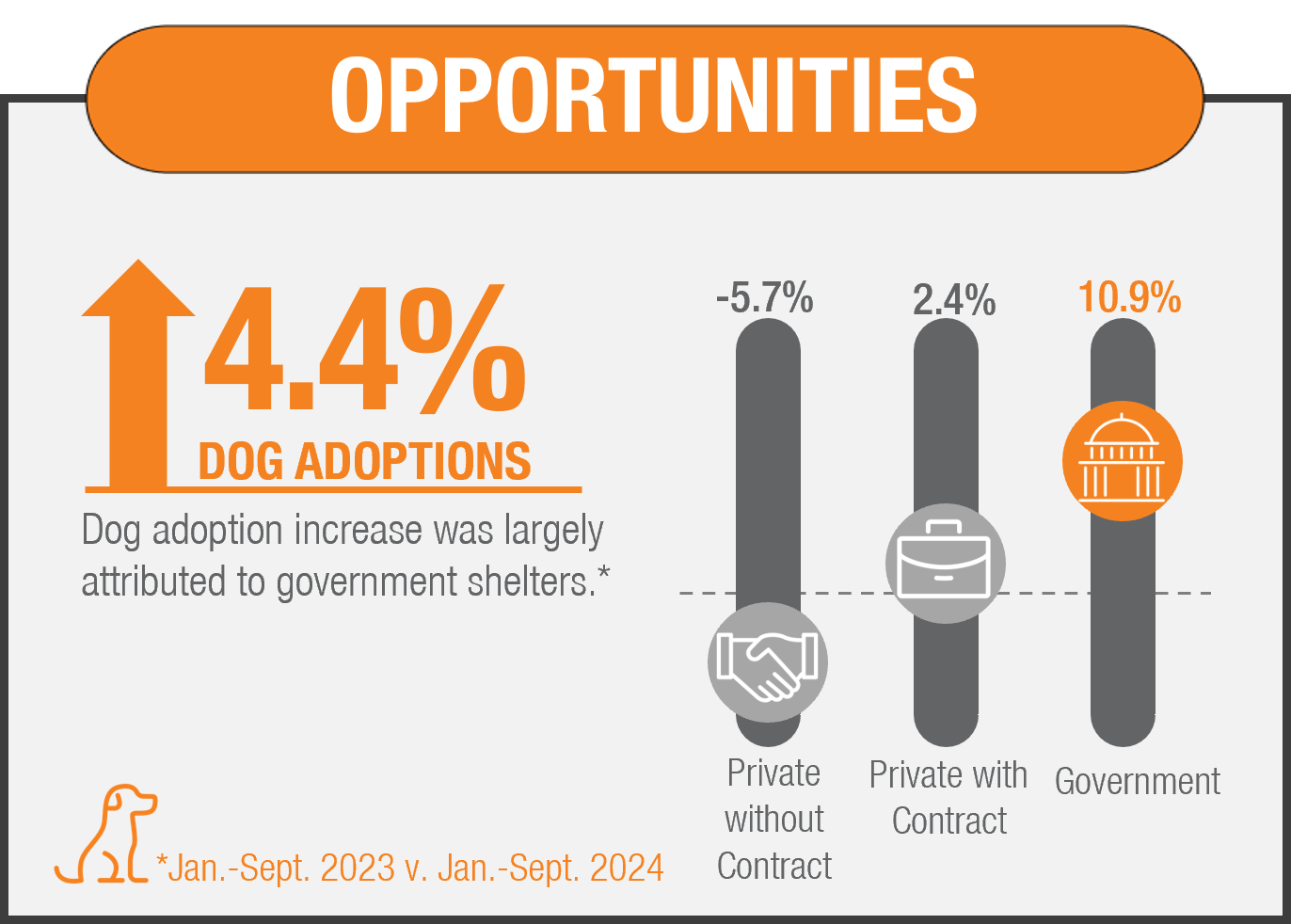
In our sample of consistently reporting shelters, dog adoptions are up 10.9% in municipal agencies and up 2.4% in private organizations with contracts, but down 5.7% in private organizations without contract.
How does your organization compare? Upload your data to shelterpetdata.org now.
Based on data from past surveys of Best Friends Network Partners, this trend is likely due to the operational practices of these organization types: private shelters without government contracts and rescues without government contracts are the least likely to practice open adoptions or facilitate same day adoptions. Though these organizations can control their intake and plan around capacity and length of stay, the wider animal welfare ecosystem relies on a steady flow of animals across organizations to avoid a backup, or capacity crisis, in the larger system. These practices are likely increasing length of stay unnecessarily, delaying transfers from capacity-crunched municipal shelters, and negatively impacting the community's collective lifesaving efforts.
Open adoptions & same-day adoptions resources
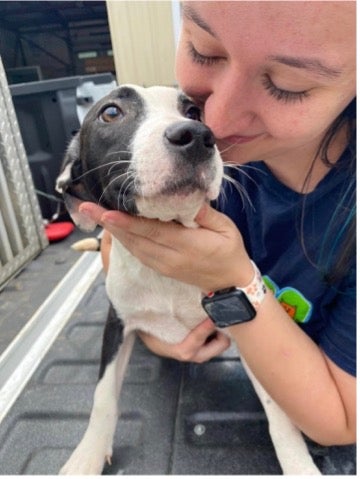
Burke County Animal Services
Burke County Animal Services in North Carolina saw a 45% adoption increase, far exceeding the national average. Director Kaitlin Settlemyre credits this to strategies like engaging the community through social media, events, partnerships, and enhanced behavior and medical support for pets. They also reduced euthanasia by 285 pets in 2024, aided by programs like pet parent resources and 'Free Ride Home' for lost pets to keep animals with their families.
Photo courtesy of the Burke County Animal Services
Dogs killed by organization type
The increase in dog intake is primarily impacting municipal agencies – with fewer dogs going to private without contract organizations via transfer from municipal or direct intake.
Municipal agencies have long counted on private organizations without contracts as a much needed destination for positive dog outcomes. The change in this landscape requires municipal shelters to solve for a greater share of animal lifesaving on their own through direct placement channels.
The good news is that municipals seem to have recognized this need and overall have been successful in expanding community adoption rates; however, these numbers do not fully make up for the decrease in transfers from private shelters without contracts. This trend, paired with municipal agencies’ limited ability to determine the types of animals entering their facilities, leave municipals disproportionately shouldering the increase in dogs killed.
The Bottom Line:
Organizations do not operate within silos; they are part of an interdependent ecosystem. For a community to achieve no-kill, all organizations must collaborate and share the onus of lifesaving.
Private organizations play a critical role in the animal welfare ecosystem by transferring animals and facilitating adoptions (and often much more than that), saving countless lives, and easing the burden on municipal shelters. To make progress towards no-kill for the rest of the year and into 2025, private shelters and rescue organizations must increase their intake and adoption rates so they have more capacity to help their partner municipal agencies through animal transfer or intake diversion. Additionally, organizations of every type should capitalize on positive adoption trends and make sure their adoption process is open, barrier-free, and focused on saving as many animals as possible. A Best Friends survey* on adoption practices identified a variety of common barriers to adoption, including:
1
Language barriers: 85% of organizations lack multilingual adoption applications.
2
Delays in adoption processes: 65% of organizations cannot process same-day adoptions.
3
Adoption costs: 47% rarely reduce fees, and 66% rarely waive them.
4
Facility accessibility: 45% of facilities are closed on Saturdays, and 74% close by 5pm on weekdays.
*Network partners open adoptions survey in April 2024

Humane Society of Jefferson County
The Humane Society of Jefferson County in Wisconsin shifted toward a more welcoming, less restrictive approach like no longer requiring an approved application before a meet-and-greet or requiring the entire family to meet the pet before adoption and removing landlord checks.
This shift has nearly doubled their adoptions in 2024, with 1,192 adoptions by October compared to 636 last year. Executive Director Tom DeLadurantey says it’s all been done by becoming “people-centric vs. paper-centric, focusing on making sure the fit is good for the person and pet.”
Photo courtesy of the Humane Society of Jefferson County
As we know, each community is unique, so it’s important to leverage your own data. However, based on the national data for dogs, the pathway for industry success seems clear:
The public demand for adopting dogs has not stopped; municipal agencies have shown a pathway for increasing adoptions. All adoption organizations must continue to increase animal marketing, provide good customer service and implement barrier-free adoption practices so that the public is aware of your community’s needs and is able to participate in the solutions.
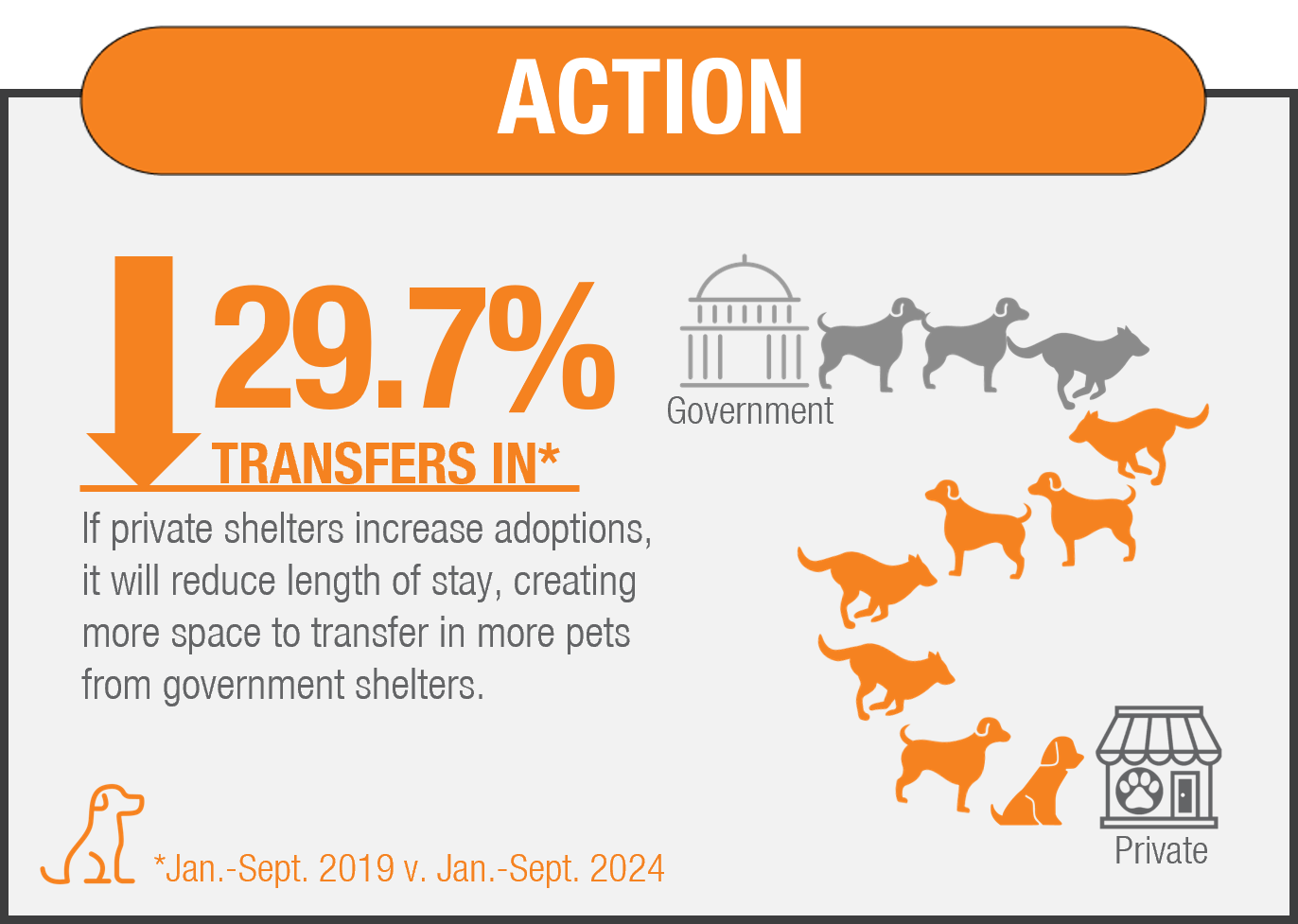
Lastly, private agencies without contracts and foster-based rescues – the industry needs you right now. While organizations of all types are experiencing capacity challenges, your transfers in remain well below pre-pandemic totals, giving you a unique opportunity to support additional lifesaving in your community by increasing collaboration and decreasing placement barriers.
How does your organization compare? Upload your data to shelterpetdata.org now.

Hearts & Bones
In 2024, collaboration is how Hearts & Bones has saved more lives than ever before. HBR helps Dallas-based source shelters and typically adopts them out in New York. But this year they launched their new transfer program, transferring out Dallas dogs to trusted partner receiving rescues and shelters across the country, enabling them to increase their transfers-out by nearly 10 times. They also increased their adoptions by 20% by focusing on their foster-to-adopt program, improving customer service, and increasing their adoption events in New York.
Photo courtesy of Hearts & Bones
** Analysis based on a sample of 777 shelters that reported Jan-Sept 2023 and Jan-Sept 2024 monthly data (with 48% being municipal, 28% contract, and 24% private non-profits without contract).